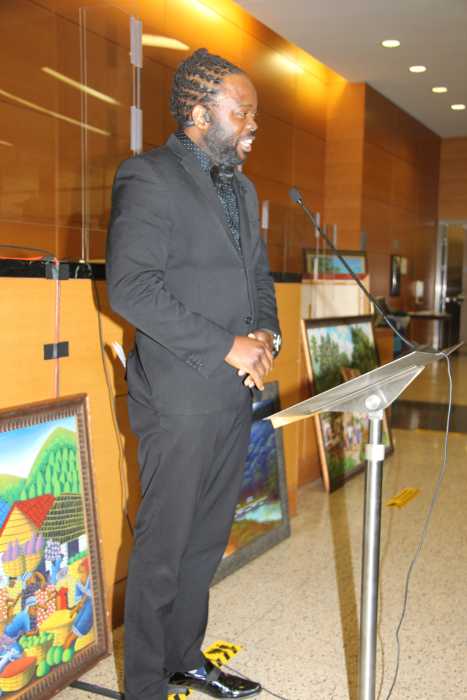LaGuardia Concert Hall rollick a smash success for choreographer, troupe
Richard Termine
By GUS SOLOMONS JR.
One of the two dance attractions at this year’s “Mostly Mozart Festival,” “Mozart/Concert Arias, un moto di gioia” (“A Flash of Joy”), choreographed in 1992 by Belgian wunderkind Anne Teresa De Keersmaeker and directed by Jan-Luc Ducourt, romps through a series of relationships between youthful men and women who are vying for attention and longing for affection. De Keersmaeker keeps the stage hopping with abundant action. Take your pick of what to watch.
The dance, performed August 25, is a sprawling collage of piquant, full-bodied movement images, set to 24 pieces by Mozart, played buoyantly by the Orchestra of St. Luke’s under the deft baton of Gregory Vajda, with John Van Buskirk at an onstage fortepiano and gloriously rich sopranos Patrizia Bicciré, Anke Herrmann and Olga Pasichnyk, who move gracefully around the stage. Dancers hurtle to the floor then rear back on the tops of their feet, roll like logs, jump up and down waving arms in a madcap semaphore, and race around the stage, veering perilously close to the front edge that slopes toward the orchestra pit.
Costumes by Rudy Sabounghi fancifully recall 18th century tailcoats and gowns, as well as contemporary Calvin Klein-inspired black suit jackets over miniskirts on the women and white shorts under puffy blouses for the men. Herman Sorgeloos’s setting of boxed hedges in forced perspective, hung on the rear wall, and an oval parquet floor, raked at two different angles, creates an elegant drawing room overlooking a garden. Ducourt’s expert lighting constantly shifts the character of the space.
Like the dancers of the Mark Morris Group—the only other Mostly Mozart dance attraction this year—De Keersmaeker’s dancers captivate us, not with technical virtuosity, but rather the individuality of their personalities, keen musicality and thoroughly engaging humanity. We get to know and like each of them—tiny atomic-powered Marion Lévy; tall, spidery Igor Shyshko; brash, kick-boxing Vincent Dunoyer; big, Modigliani-esque Rosalba Torres Guerrero; hippie-ish Bruce Campbell with a scruffy ponytail; wholesome blond Johan Thelander; take-no-prisoners Samantha Van Wissen; kittenish Fumiyo Ikeda; lithe Taka Shamoto; sanguine Elizaveta Penkova; sultry Marta Coronado and sexy heartthrob Jakub Truszkowski.
The two unbroken hours of “un moto di gioia” test our endurance and that of the dancers, and some of the minimalist walking patterns, endlessly repeated during a few of the longer arias, seem like unnecessary padding. But overall, De Keersmaeker’s craft redeems her. Better known for more abstract works, though always with implicit emotionality just beneath the surface, here she resorts to slapstick and playing broadly to the audience to underline the humor. The movement takes its emotional cues from the lyrics, though it’s hard to relate the action specifically to the words, unless you’re fluent in Italian. The mostly music fans who comprise most of the “Mostly Mozart” audience signal their approval of the antics with frequent applause and a rousing final ovation.
Taking kinetic cues from various aspects of the music, De Keersmaeker invents a rich panoply of movement. Sometimes it mirrors the style, as when the ladies stiffly strut and elegantly pose; or the rhythm, as in several lively unison jigs; or the tone, as when the dancers repeatedly throw themselves to the ground in hyperbolic distress or slither and prowl like hungry beasts.
At the end of the first aria, dancer Dunoyer sweeps singer Herrmann up in his arms and whirls her offstage. Later, she reciprocates for him! Indeed, reversal is the salient structural theme of the piece. Torres Guerrero does a solo with men posted along the rim of the stage in front of her. Later the women form a similar colonnade for Shyshko’s solo. Coronado crawls across the stage in a leopard skin dress, puffed out with 18th century panniers. Later on, rambunctious Dunoyer, wearing the same gown, reprises his kickboxing solo
Levy does the fastest hand-and-knees crawl you’ve ever seen. Penkova sobs aloud, while Dunoyer convulses at her feet; and soprano Pasichnyk stops the show with her brilliant rendition of the aria “Bella mia fiamma.” In the manner of Mozart’s music, the choreographic structure contains many musical devices—recapitulation, retrograde, counterpoint, as well as ironic twists. Van Wissen throws a disco-dancing tantrum, fruging and moon-walking in her brocade gown and low-heeled pumps to a Mozart ditty, before Thelander tries to impress soprano Bicciré, as she warbles in her sparkling coloratura, with his crotch-grabbing Michael Jackson routine that fits Mozart’s beat like a glove.
We also publish:
ADVERTISING



































